2017 NISSAN ROGUE check engine
[x] Cancel search: check enginePage 498 of 547
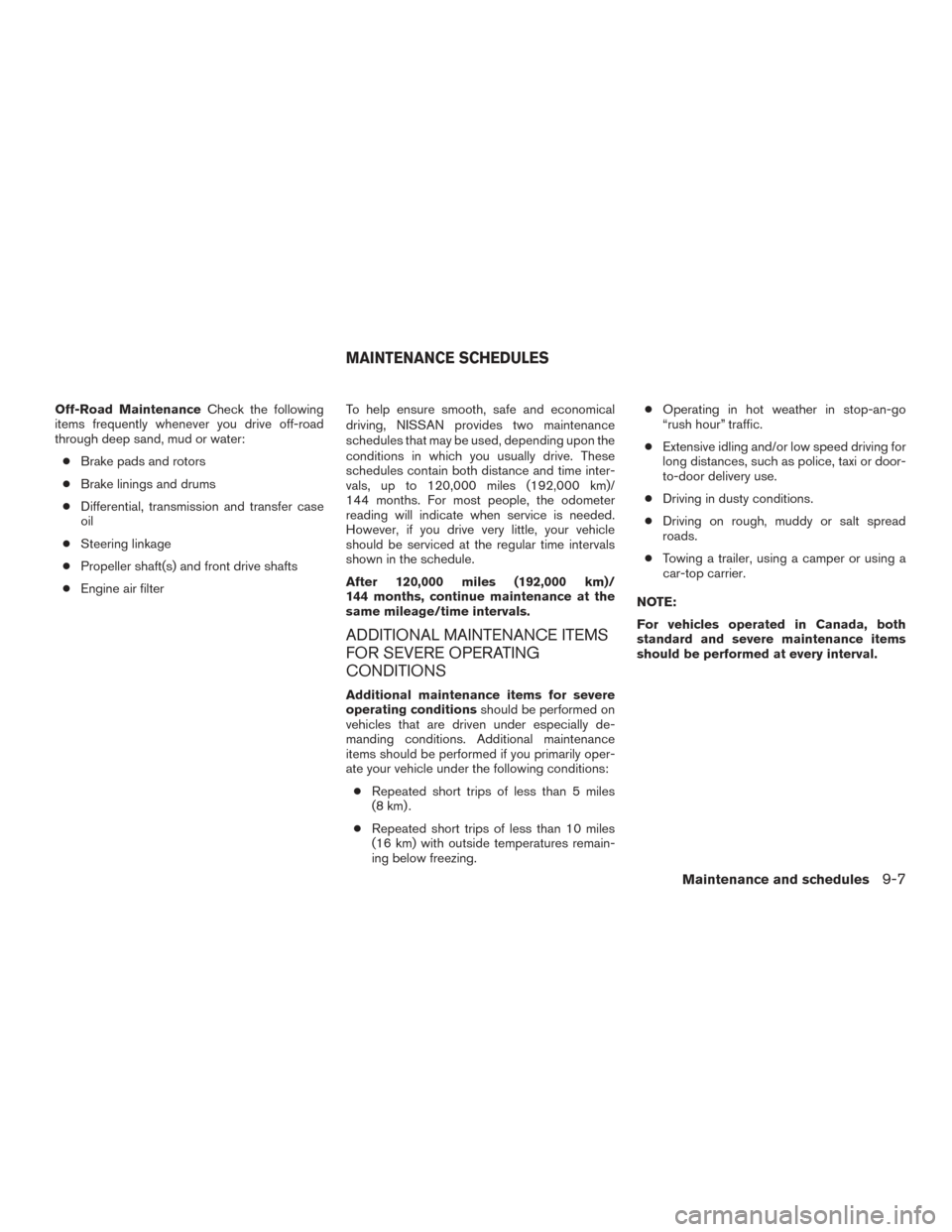
Off-Road MaintenanceCheck the following
items frequently whenever you drive off-road
through deep sand, mud or water:
● Brake pads and rotors
● Brake linings and drums
● Differential, transmission and transfer case
oil
● Steering linkage
● Propeller shaft(s) and front drive shafts
● Engine air filter To help ensure smooth, safe and economical
driving, NISSAN provides two maintenance
schedules that may be used, depending upon the
conditions in which you usually drive. These
schedules contain both distance and time inter-
vals, up to 120,000 miles (192,000 km)/
144 months. For most people, the odometer
reading will indicate when service is needed.
However, if you drive very little, your vehicle
should be serviced at the regular time intervals
shown in the schedule.
After 120,000 miles (192,000 km)/
144 months, continue maintenance at the
same mileage/time intervals.
ADDITIONAL MAINTENANCE ITEMS
FOR SEVERE OPERATING
CONDITIONS
Additional maintenance items for severe
operating conditions
should be performed on
vehicles that are driven under especially de-
manding conditions. Additional maintenance
items should be performed if you primarily oper-
ate your vehicle under the following conditions:
● Repeated short trips of less than 5 miles
(8 km) .
● Repeated short trips of less than 10 miles
(16 km) with outside temperatures remain-
ing below freezing. ●
Operating in hot weather in stop-an-go
“rush hour” traffic.
● Extensive idling and/or low speed driving for
long distances, such as police, taxi or door-
to-door delivery use.
● Driving in dusty conditions.
● Driving on rough, muddy or salt spread
roads.
● Towing a trailer, using a camper or using a
car-top carrier.
NOTE:
For vehicles operated in Canada, both
standard and severe maintenance items
should be performed at every interval.
MAINTENANCE SCHEDULES
Maintenance and schedules9-7
Page 513 of 547
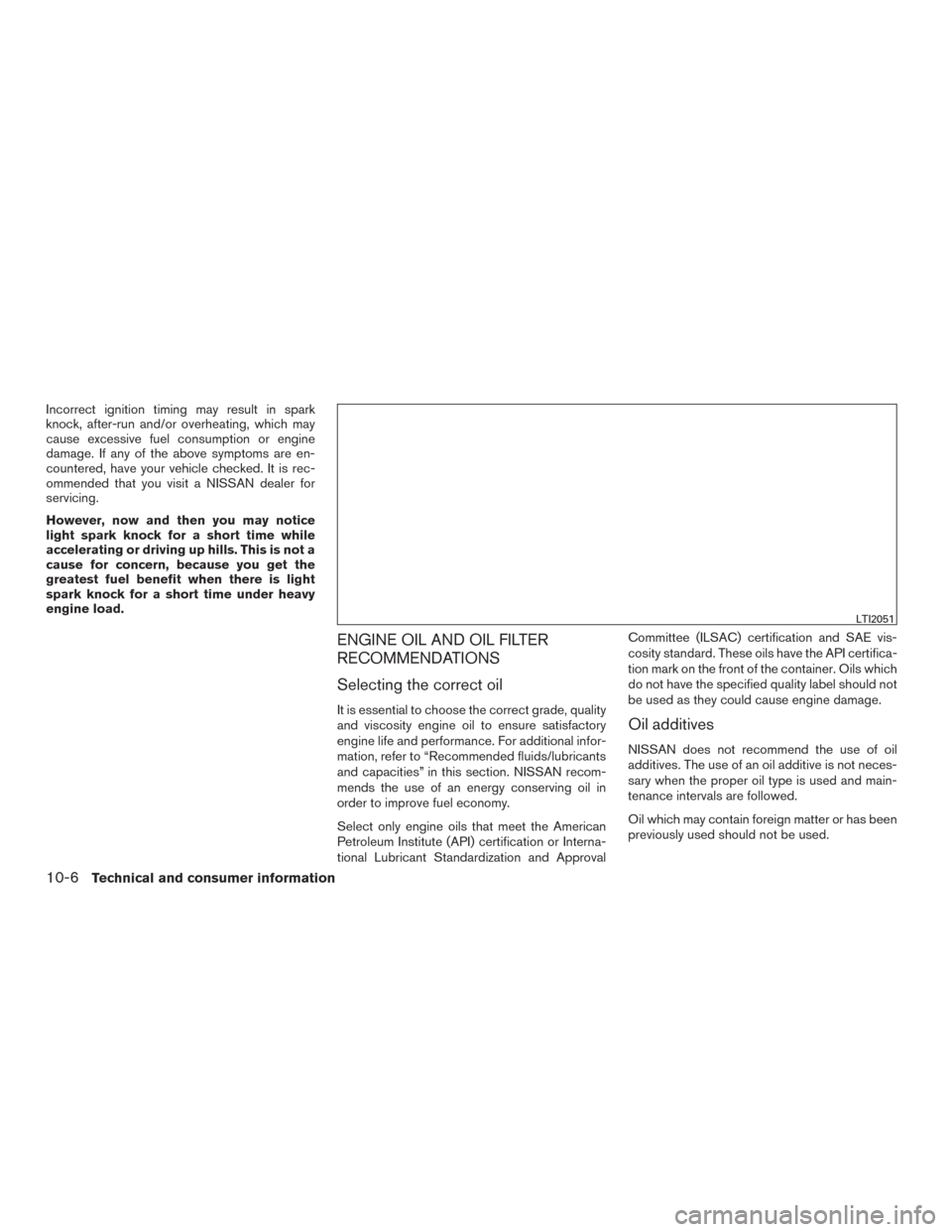
Incorrect ignition timing may result in spark
knock, after-run and/or overheating, which may
cause excessive fuel consumption or engine
damage. If any of the above symptoms are en-
countered, have your vehicle checked. It is rec-
ommended that you visit a NISSAN dealer for
servicing.
However, now and then you may notice
light spark knock for a short time while
accelerating or driving up hills. This is not a
cause for concern, because you get the
greatest fuel benefit when there is light
spark knock for a short time under heavy
engine load.
ENGINE OIL AND OIL FILTER
RECOMMENDATIONS
Selecting the correct oil
It is essential to choose the correct grade, quality
and viscosity engine oil to ensure satisfactory
engine life and performance. For additional infor-
mation, refer to “Recommended fluids/lubricants
and capacities” in this section. NISSAN recom-
mends the use of an energy conserving oil in
order to improve fuel economy.
Select only engine oils that meet the American
Petroleum Institute (API) certification or Interna-
tional Lubricant Standardization and ApprovalCommittee (ILSAC) certification and SAE vis-
cosity standard. These oils have the API certifica-
tion mark on the front of the container. Oils which
do not have the specified quality label should not
be used as they could cause engine damage.Oil additives
NISSAN does not recommend the use of oil
additives. The use of an oil additive is not neces-
sary when the proper oil type is used and main-
tenance intervals are followed.
Oil which may contain foreign matter or has been
previously used should not be used.
LTI2051
10-6Technical and consumer information
Page 532 of 547
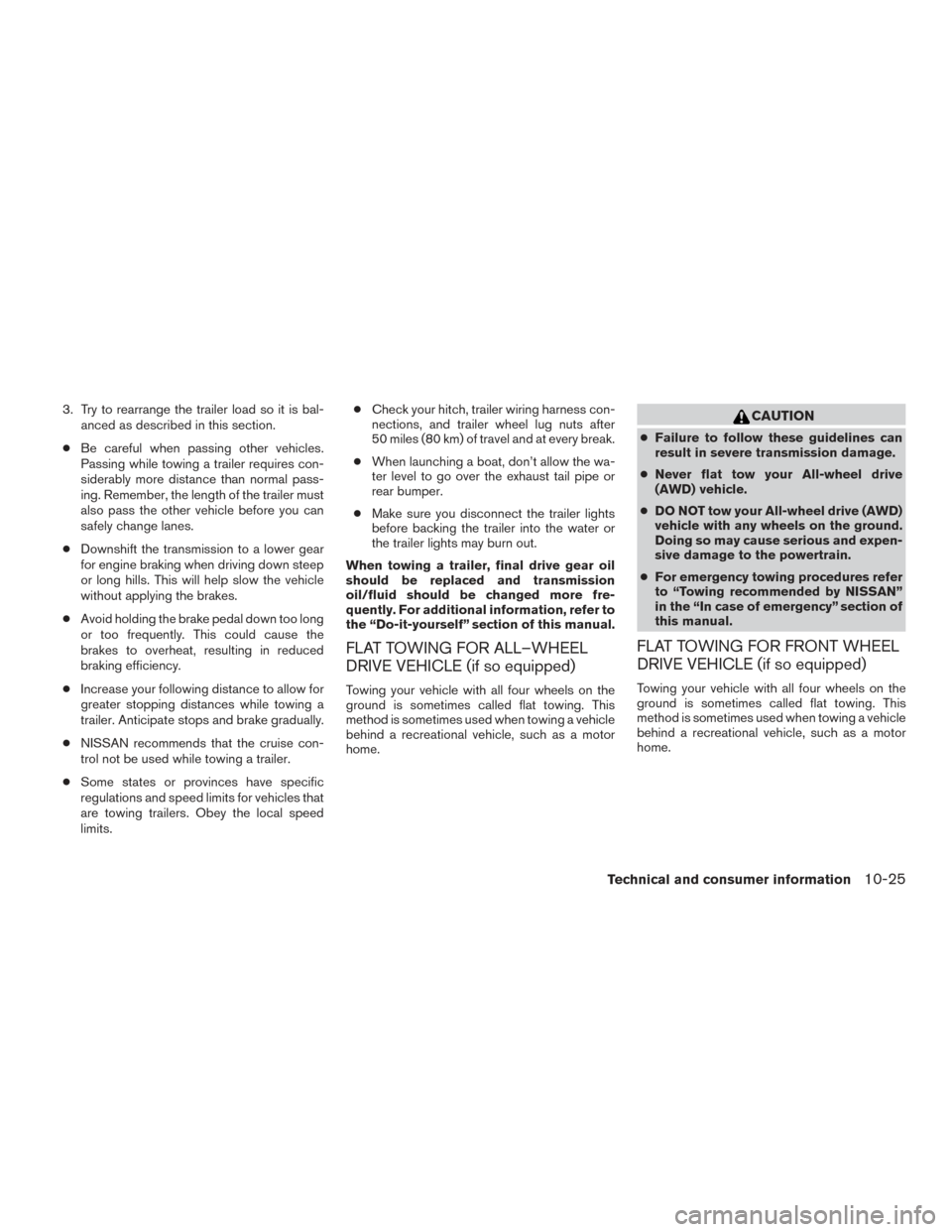
3. Try to rearrange the trailer load so it is bal-anced as described in this section.
● Be careful when passing other vehicles.
Passing while towing a trailer requires con-
siderably more distance than normal pass-
ing. Remember, the length of the trailer must
also pass the other vehicle before you can
safely change lanes.
● Downshift the transmission to a lower gear
for engine braking when driving down steep
or long hills. This will help slow the vehicle
without applying the brakes.
● Avoid holding the brake pedal down too long
or too frequently. This could cause the
brakes to overheat, resulting in reduced
braking efficiency.
● Increase your following distance to allow for
greater stopping distances while towing a
trailer. Anticipate stops and brake gradually.
● NISSAN recommends that the cruise con-
trol not be used while towing a trailer.
● Some states or provinces have specific
regulations and speed limits for vehicles that
are towing trailers. Obey the local speed
limits. ●
Check your hitch, trailer wiring harness con-
nections, and trailer wheel lug nuts after
50 miles (80 km) of travel and at every break.
● When launching a boat, don’t allow the wa-
ter level to go over the exhaust tail pipe or
rear bumper.
● Make sure you disconnect the trailer lights
before backing the trailer into the water or
the trailer lights may burn out.
When towing a trailer, final drive gear oil
should be replaced and transmission
oil/fluid should be changed more fre-
quently. For additional information, refer to
the “Do-it-yourself” section of this manual.
FLAT TOWING FOR ALL–WHEEL
DRIVE VEHICLE (if so equipped)
Towing your vehicle with all four wheels on the
ground is sometimes called flat towing. This
method is sometimes used when towing a vehicle
behind a recreational vehicle, such as a motor
home.
CAUTION
● Failure to follow these guidelines can
result in severe transmission damage.
● Never flat tow your All-wheel drive
(AWD) vehicle.
● DO NOT tow your All-wheel drive (AWD)
vehicle with any wheels on the ground.
Doing so may cause serious and expen-
sive damage to the powertrain.
● For emergency towing procedures refer
to “Towing recommended by NISSAN”
in the “In case of emergency” section of
this manual.
FLAT TOWING FOR FRONT WHEEL
DRIVE VEHICLE (if so equipped)
Towing your vehicle with all four wheels on the
ground is sometimes called flat towing. This
method is sometimes used when towing a vehicle
behind a recreational vehicle, such as a motor
home.
Technical and consumer information10-25
Page 536 of 547
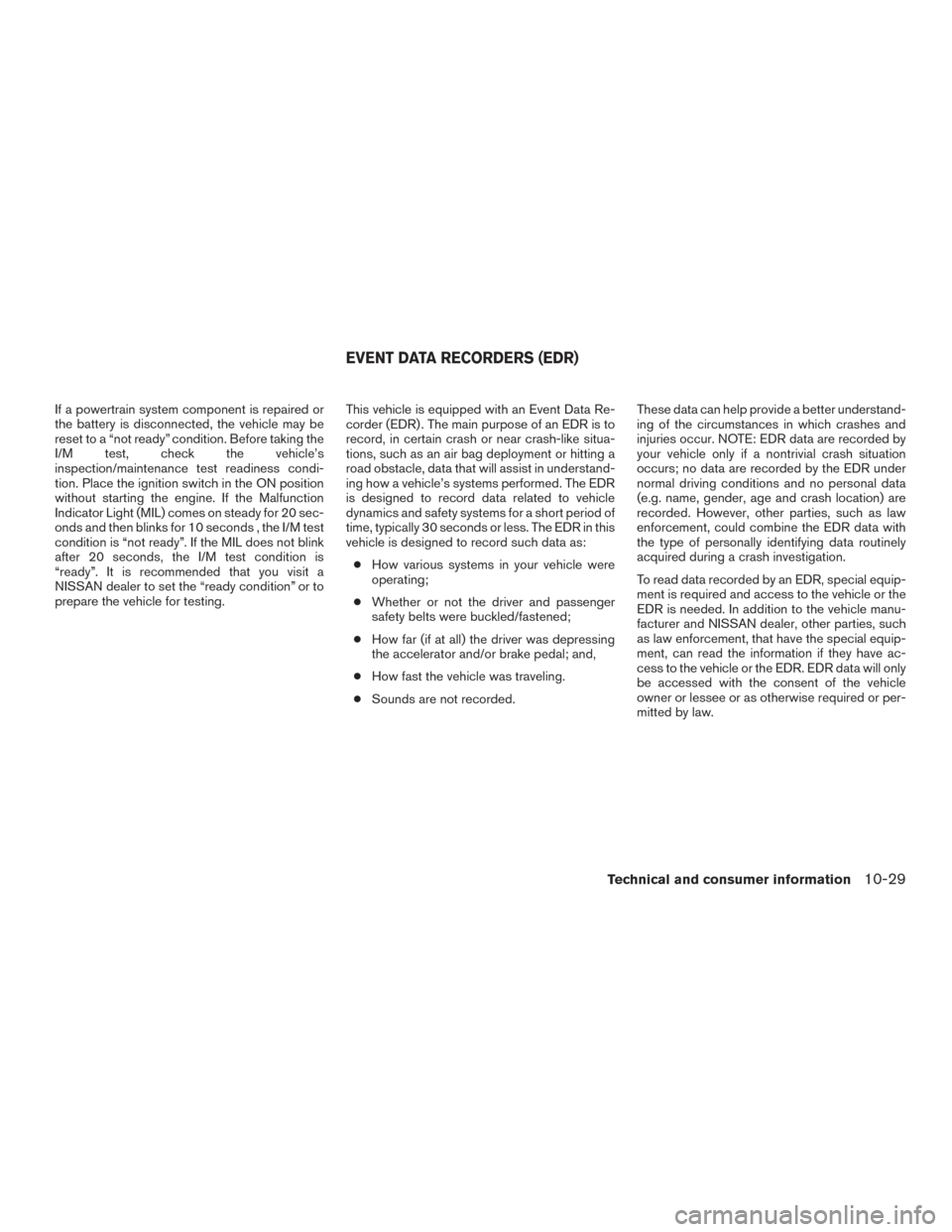
If a powertrain system component is repaired or
the battery is disconnected, the vehicle may be
reset to a “not ready” condition. Before taking the
I/M test, check the vehicle’s
inspection/maintenance test readiness condi-
tion. Place the ignition switch in the ON position
without starting the engine. If the Malfunction
Indicator Light (MIL) comes on steady for 20 sec-
onds and then blinks for 10 seconds , the I/M test
condition is “not ready”. If the MIL does not blink
after 20 seconds, the I/M test condition is
“ready”. It is recommended that you visit a
NISSAN dealer to set the “ready condition” or to
prepare the vehicle for testing.This vehicle is equipped with an Event Data Re-
corder (EDR) . The main purpose of an EDR is to
record, in certain crash or near crash-like situa-
tions, such as an air bag deployment or hitting a
road obstacle, data that will assist in understand-
ing how a vehicle’s systems performed. The EDR
is designed to record data related to vehicle
dynamics and safety systems for a short period of
time, typically 30 seconds or less. The EDR in this
vehicle is designed to record such data as:
● How various systems in your vehicle were
operating;
● Whether or not the driver and passenger
safety belts were buckled/fastened;
● How far (if at all) the driver was depressing
the accelerator and/or brake pedal; and,
● How fast the vehicle was traveling.
● Sounds are not recorded. These data can help provide a better understand-
ing of the circumstances in which crashes and
injuries occur. NOTE: EDR data are recorded by
your vehicle only if a nontrivial crash situation
occurs; no data are recorded by the EDR under
normal driving conditions and no personal data
(e.g. name, gender, age and crash location) are
recorded. However, other parties, such as law
enforcement, could combine the EDR data with
the type of personally identifying data routinely
acquired during a crash investigation.
To read data recorded by an EDR, special equip-
ment is required and access to the vehicle or the
EDR is needed. In addition to the vehicle manu-
facturer and NISSAN dealer, other parties, such
as law enforcement, that have the special equip-
ment, can read the information if they have ac-
cess to the vehicle or the EDR. EDR data will only
be accessed with the consent of the vehicle
owner or lessee or as otherwise required or per-
mitted by law.
EVENT DATA RECORDERS (EDR)
Technical and consumer information10-29
Page 538 of 547
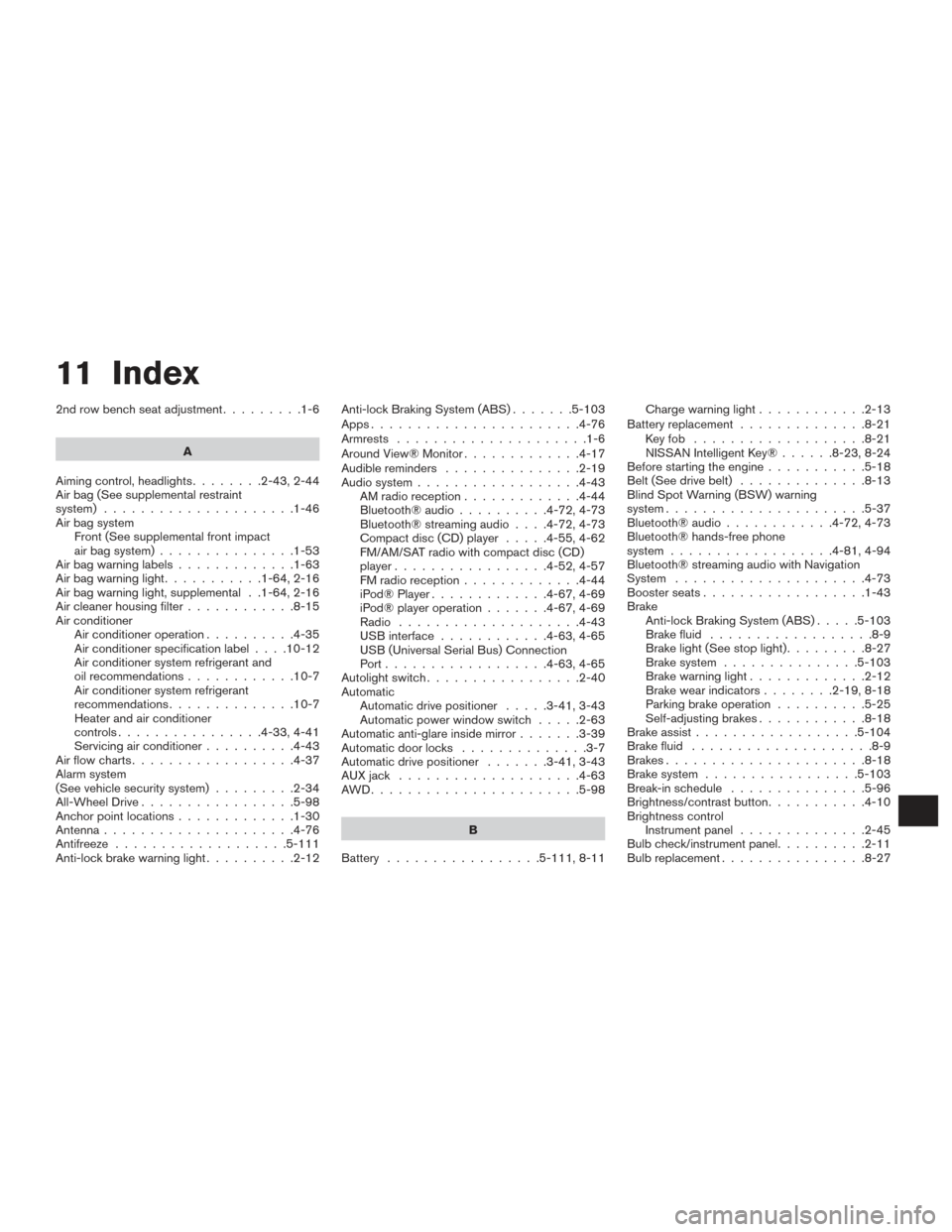
11 Index
2nd row bench seat adjustment.........1-6
A
Aiming control, headlights ........2-43,2-44
Air bag (See supplemental restraint
system) .....................1-46
Air bag system Front (See supplemental front impact
air bag system) ...............1-53
Airbagwarninglabels.............1-63
Airbagwarninglight...........1-64,2-16
Air bag warning light, supplemental . .1-64, 2-16
Air cleaner housing filter ............8-15
Air conditioner Air conditioner operation ..........4-35
Air conditioner specification label ....10-12
Air conditioner system refrigerant and
oil recommendations ............10-7
Air conditioner system refrigerant
recommendations ..............10-7
Heater and air conditioner
controls................4-33,4-41
Servicing air conditioner ..........4-43
Airflowcharts..................4-37
Alarm system
(See vehicle security system) .........2-34
All-Wheel Drive .................5-98
Anchor point locations .............1-30
Antenna .....................4-76
Antifreeze ...................5-111
Anti-lock brake warning light ..........2-12Anti-lock Braking System (ABS)
.......5-103
Apps .......................4-76
Armrests .....................1-6
AroundView®Monitor.............4-17
Audible reminders ...............2-19
Audio system ..................4-43
AMradioreception.............4-44
Bluetooth®audio..........4-72,4-73
Bluetooth® streaming audio ....4-72,4-73
Compact disc (CD) player .....4-55,4-62
FM/AM/SAT radio with compact disc (CD)
player.................4-52,4-57
FMradioreception.............4-44
iPod® Player .............4-67,4-69
iPod® player operation .......4-67,4-69
Radio ....................4-43
USB interface ............4-63,4-65
USB (Universal Serial Bus) Connection
Port..................4-63,4-65
Autolight switch .................2-40
Automatic Automatic drive positioner .....3-41,3-43
Automatic power window switch .....2-63
Automatic anti-glare inside mirror .......3-39
Automatic door locks ..............3-7
Automatic drive positioner .......3-41,3-43
AUXjack ....................4-63
AWD.......................5-98
B
Battery .................5- 111, 8-11Charge warning light
............2-13
Battery replacement ..............8-21
Keyfob ...................8-21
NISSAN Intelligent Key® ......8-23,8-24
Before starting the engine ...........5-18
Belt (See drive belt) ..............8-13
Blind Spot Warning (BSW) warning
system......................5-37
Bluetooth® audio ............4-72,4-73
Bluetooth® hands-free phone
system..................4-81,4-94
Bluetooth® streaming audio with Navigation
System .....................4-73
Boosterseats..................1-43
Brake Anti-lock Braking System (ABS) .....5-103
Brake fluid ..................8-9
Brakelight(Seestoplight).........8-27
Brake system ...............5-103
Brakewarninglight.............2-12
Brakewearindicators........2-19,8-18
Parking brake operation ..........5-25
Self-adjusting brakes ............8-18
Brake assist ..................5-104
Brake fluid ....................8-9
Brakes ......................
8-18
Brake system .................5-103
Break-inschedule ...............5-96
Brightness/contrast button ...........4-10
Brightness control Instrument panel ..............2-45
Bulb check/instrument panel ..........2-11
Bulbreplacement................8-27
Page 539 of 547
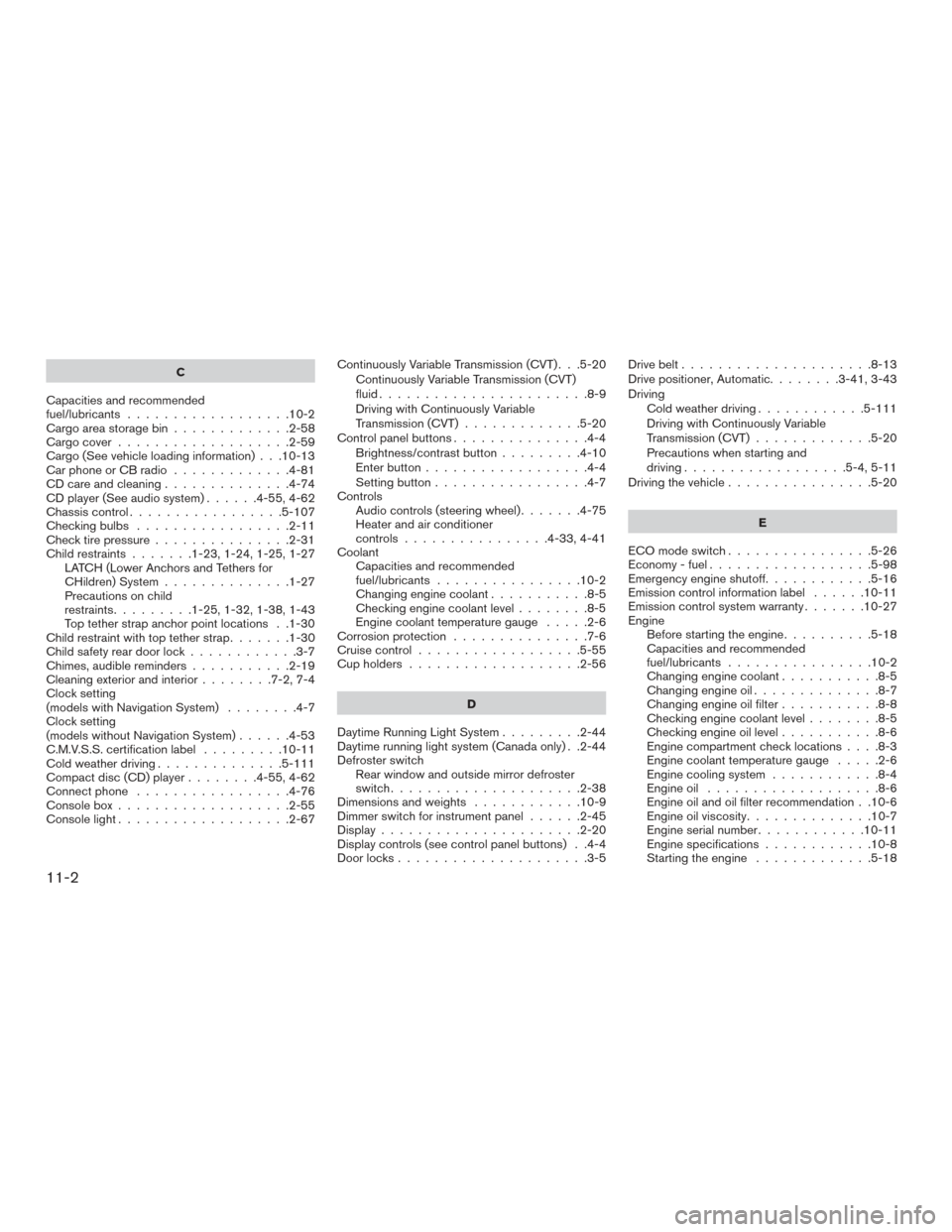
C
Capacities and recommended
fuel/lubricants ..................10-2
Cargoareastoragebin.............2-58
Cargocover...................2-59
Cargo (See vehicle loading information) . . .10-13
Car phone or CB radio .............4-81
CD care and cleaning ..............4-74
CD player (See audio system) ......4-55,4-62
Chassiscontrol.................5-107
Checkingbulbs .................2-11
Check tire pressure ...............2-31
Child restraints .......1-23,1-24,1-25,1-27
LATCH (Lower Anchors and Tethers for
CHildren) System ..............1-27
Precautions on child
restraints.........1-25,1-32,1-38,1-43
Top tether strap anchor point locations . .1-30
Child restraint with top tether strap .......1-30
Child safety rear door lock ............3-7
Chimes, audible reminders ...........2-19
Cleaningexteriorandinterior........7-2,7-4
Clock setting
(models with Navigation System) ........4-7
Clock setting
(models without Navigation System) ......4-53
C.M.V.S.S. certification label .........10-11
Cold weather driving ..............5-111
Compact disc (CD) player ........4-55,4-62
Connect phone .................4-76
Consolebox...................2-55
Consolelight...................2-67 Continuously Variable Transmission (CVT) . . .5-20
Continuously Variable Transmission (CVT)
fluid.......................8-9
Driving with Continuously Variable
Transmission (CVT) .............5-20
Control panel buttons ...............4-4
Brightness/contrast button .........4-10
Enterbutton..................4-4
Setting button .................4-7
Controls Audio controls (steering wheel) .......4-75
Heater and air conditioner
controls................4-33,4-41
Coolant Capacities and recommended
fuel/lubricants ................10-2
Changingenginecoolant...........8-5
Checking engine coolant level ........8-5
Engine coolant temperature gauge .....2-6
Corrosion protection ...............7-6
Cruisecontrol..................5-55
Cupholders...................2-56
D
Daytime Running Light System .........2-44
Daytime running light system (Canada only) . .2-44
Defroster switch Rear window and outside mirror defroster
switch.....................2-38
Dimensionsandweights ............10-9
Dimmer switch for instrument panel ......2-45
Display......................2-20
Display controls (see control panel buttons) . .4-4
Door locks .....................3-5 Drive belt
.....................8-13
Drive positioner, Automatic ........3-41,3-43
Driving Cold weather driving ............5-111
Driving with Continuously Variable
Transmission (CVT) .............5-20
Precautions when starting and
driving ..................5-4,5-11
Driving the vehicle ................5-20
E
ECO mode switch ................5-26
Economy-fuel..................5-98
Emergency engine shutoff ............5-16
Emission control information label ......10-11
Emission control system warranty .......10-27
Engine Before starting the engine ..........5-18
Capacities and recommended
fuel/lubricants ................10-2
Changing engine coolant ...........8-5
Changingengineoil..............8-7
Changing engine oil filter ...........8-8
Checking engine coolant level ........8-5
Checking engine oil level ...........8-6
Engine
compartment check locations ....8-3
Engine coolant temperature gauge .....2-6
Engine cooling system ............8-4
Engineoil ...................8-6
Engine oil and oil filter recommendation . .10-6
Engine oil viscosity ..............10-7
Engine serial number ............10-11
Engine specifications ............10-8
Starting the engine .............5-18
11-2
Page 541 of 547
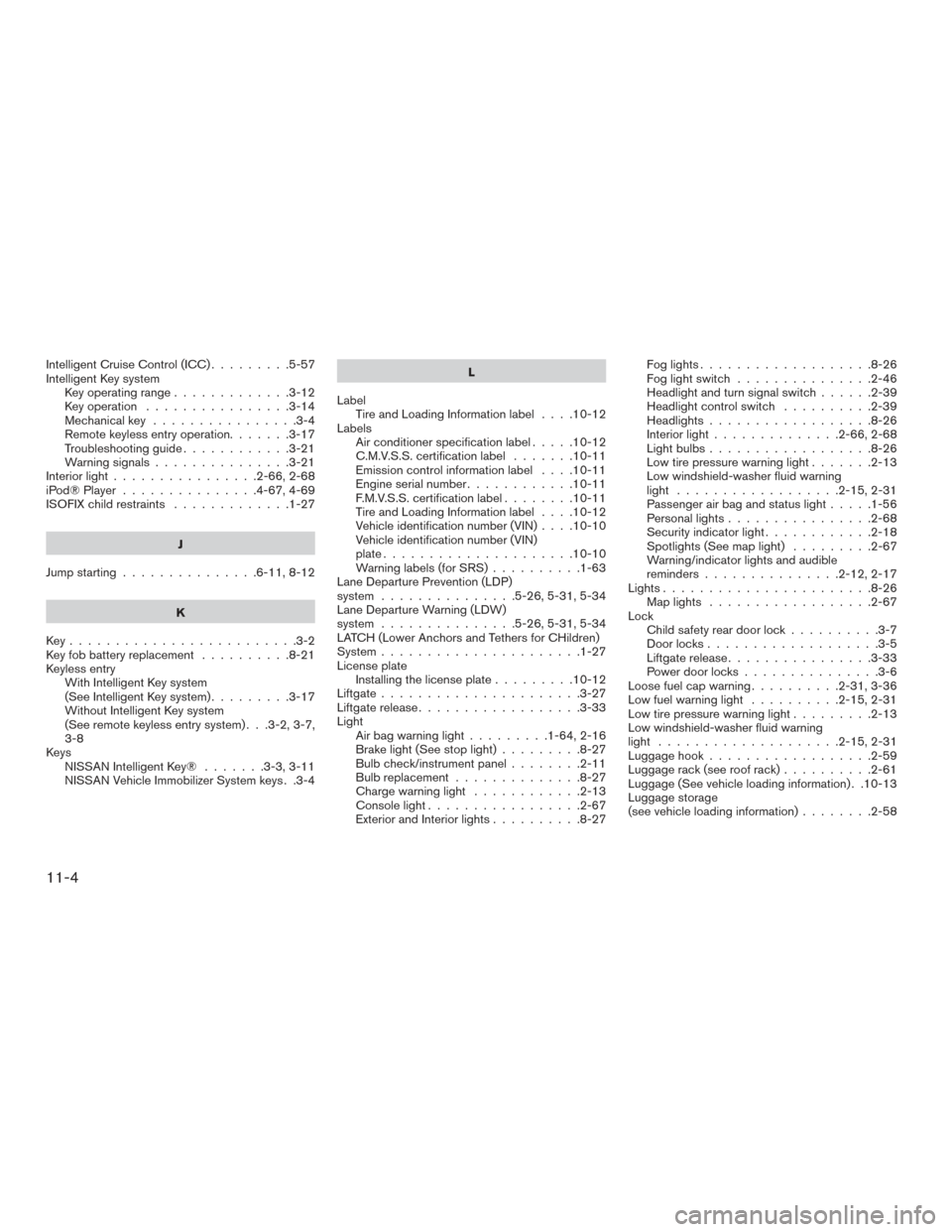
Intelligent Cruise Control (ICC).........5-57
Intelligent Key system Key operating range .............3-12
Key operation ................3-14
Mechanicalkey ................3-4
Remote keyless entry operation.......3-17
Troubleshooting guide ............3-21
Warning signals ...............3-21
Interiorlight................2-66,2-68
iPod®Player ...............4-67,4-69
ISOFIX child restraints .............1-27
J
Jump starting ...............6-11,8-12
K
Key.........................3-2
Key fob battery replacement ..........8-21
Keyless entry With Intelligent Key system
(See Intelligent Key system) .........3-17
Without Intelligent Key system
(See remote keyless entry system) . . .3-2, 3-7,
3-8
Keys NISSAN Intelligent Key® .......3-3,3-11
NISSAN Vehicle Immobilizer System keys . .3-4 L
Label Tire and Loading Information label ....10-12
Labels Air conditioner specification label .....10-12
C.M.V.S.S. certification label .......10-11
Emission control information label ....10-11
Engine serial number ............10-11
F.M.V.S.S. certification label ........10-11
Tire and Loading Information label ....10-12
Vehicle identification number (VIN) ....10-10
Vehicle identification number (VIN)
plate.....................10-10
Warning labels (for SRS) ..........1-63
Lane Departure Prevention (LDP)
system ...............5-26,5-31,5-34
Lane Departure Warning (LDW)
system ...............5-26,5-31,5-34
LATCH (Lower Anchors and Tethers for CHildren)
System ......................1-27
License plate Installing the license plate .........10-12
Liftgate ......................3-27
Liftgate release ..................3-33
Light Air bag warning light .........1-64,2-16
Brake light (See stop light) .........8-27
Bulb check/instrument panel ........2-11
Bulbreplacement..............8-27
Charge warning light ............2-13
Consolelight.................2-67
Exterior and Interior lights ..........8-27 Foglights...................8-26
Fog light switch
...............2-46
Headlightandturnsignalswitch......2-39
Headlight control switch ..........2-39
Headlights..................8-26
Interiorlight..............2-66,2-68
Lightbulbs..................8-26
Low tire pressure warning light .......2-13
Low windshield-washer fluid warning
light ..................2-15,2-31
Passenger air bag and status light .....1-56
Personal lights ................2-68
Security indicator light ............2-18
Spotlights(Seemaplight) .........2-67
Warning/indicator lights and audible
reminders ...............2-12,2-17
Lights.......................8-26 Maplights ..................2-67
Lock Child safety rear door lock ..........3-7
Door locks ...................3-5
Liftgate release ................3-33
Power door locks ...............3-6
Loose
fuel cap warning ..........2-31,3-36
Low fuel warning light ..........2-15,2-31
Low tire pressure warning light .........2-13
Low windshield-washer fluid warning
light ....................2-15,2-31
Luggage hook ..................2-59
Luggage rack (see roof rack) ..........2-61
Luggage (See vehicle loading information) . .10-13
Luggage storage
(see vehicle loading information) ........2-58
11-4
Page 542 of 547
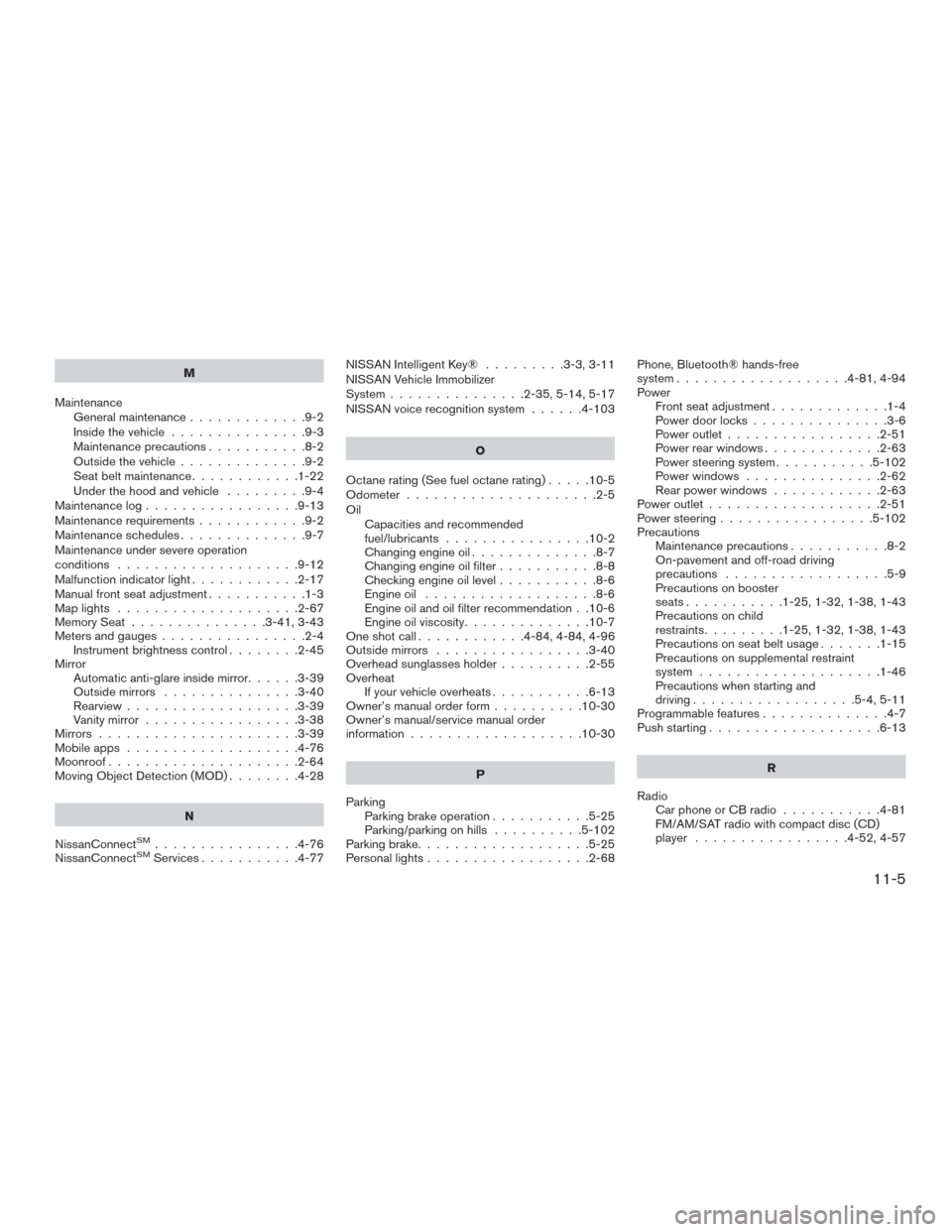
M
Maintenance General maintenance .............9-2
Insidethevehicle...............9-3
Maintenance precautions ...........8-2
Outside the vehicle ..............9-2
Seat belt maintenance ............1-22
Under the hood and vehicle .........9-4
Maintenance log .................9-13
Maintenance requirements ............9-2
Maintenance schedules ..............9-7
Maintenance under severe operation
conditions ....................9-12
Malfunction indicator light ............2-17
Manual front seat adjustment ...........1-3
Maplights ....................2-67
Memory Seat ...............3-41,3-43
Meters and gauges ................2-4
Instrument brightness control ........2-45
Mirror Automatic anti-glare inside mirror ......3-39
Outside mirrors ...............3-40
Rearview ...................3-39
Vanity mirror .................3-38
Mirrors ......................3-39
Mobileapps ...................4-76
Moonroof .....................2-64
Moving Object Detection (MOD) ........4-28
N
NissanConnect
SM................4-76
NissanConnectSMServices...........4-77 NISSAN Intelligent Key®
.........3-3,3-11
NISSAN Vehicle Immobilizer
System ...............2-35,5-14,5-17
NISSAN voice recognition system ......4-103
O
Octane rating (See fuel octane rating) .....10-5
Odometer .....................2-5
Oil Capacities and recommended
fuel/lubricants ................10-2
Changingengineoil..............8-7
Changing engine oil filter ...........8-8
Checking engine oil level ...........8-6
Engine oil ...................8-6
Engine oil and oil filter recommendation . .10-6
Engine oil viscosity ..............10-7
Oneshotcall............4-84,4-84,4-96
Outside mirrors .................3-40
Overhead sunglasses holder ..........2-55
Overheat If your vehicle overheats ...........6-13
Owner’s manual order form ..........10-30
Owner’s manual/service manual order
information ...................10-30
P
Parking Parking brake operation ...........5-25
Parking/parking on hills ..........5-102
Parking brake ...................5-25
Personallights..................2-68 Phone, Bluetooth® hands-free
system
...................4-81,4-94
Power Front seat adjustment .............1-4
Powerdoorlocks...............3-6
Power outlet .................2-51
Power rear windows .............2-63
Power steering system ...........5-102
Power windows ...............2-62
Rear power windows ............2-63
Power outlet ...................2-51
Power steering .................5-102
Precautions Maintenance precautions ...........8-2
On-pavement and off-road driving
precautions ..................5-9
Precautions on booster
seats ...........1-25,1-32,1-38,1-43
Precautions on child
restraints .........1-25,1-32,1-38,1-43
Precautions on seat belt usage .......1-15
Precautions on supplemental restraint
system ....................1-46
Precautions when starting and
driving ..................5-4,5-11
Programmable features ..............4-7
Push starting ...................6-13
R
Radio CarphoneorCBradio ...........4-81
FM/AM/SAT radio with compact disc (CD)
player .................4-52,4-57
11-5